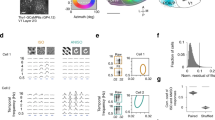Abstract
Models of visual processing often include an initial parallel stage that is restricted to relatively low-level features, whereas activation of higher-level object descriptions is generally assumed to require attention1,2,3,4. Here we report that even high-level object representations can be accessed in parallel: in a rapid animal versus non-animal categorization task, both behavioral and electrophysiological data show that human subjects were as fast at responding to two simultaneously presented natural images as they were to a single one. The implication is that even complex natural images can be processed in parallel without the need for sequential focal attention.
This is a preview of subscription content, access via your institution
Access options
Subscribe to this journal
Receive 12 print issues and online access
$209.00 per year
only $17.42 per issue
Buy this article
- Purchase on Springer Link
- Instant access to full article PDF
Prices may be subject to local taxes which are calculated during checkout


Similar content being viewed by others
References
Treisman, A. Philos. Trans. R. Soc. Lond. B Biol. Sci. 353, 1295–1306 (1998).
Wolfe, J.M. Vis. Res. 34, 1187–1195 (1994).
Kinchla, R.A. Annu. Rev. Psychol. 43, 711–742 (1992).
McElree, B. & Carrasco, M. J. Exp. Psychol. Hum. Percept. Perform. 25, 1517–1539 (1999).
Potter, M.C. J. Exp. Psychol. [Hum. Learn.] 2, 509–522 (1976).
Biederman, I. Science 177, 77–80 (1972).
Thorpe, S., Fize, D. & Marlot, C. Nature 381, 520–522 (1996).
VanRullen, R. & Thorpe, S.J. J. Cogn. Neurosci. 13, 454–461 (2001).
Fize, D. et al. Neuroimage 11, 634–643 (2000).
Schall, J.D. Nat. Rev. Neurosci. 2, 33–42 (2001).
Freedman, D.J., Riesenhuber, M., Poggio, T. & Miller, E.K. Science 291, 312–316 (2001).
Sasaki, K., Gemba, H., Nambu, A. & Matsuzaki, R. Neurosci. Res. 18, 249–252 (1993).
Duncan, J. Psychol. Rev. 87, 272–300 (1980).
Chun, M.M. & Potter, M.C. J. Exp. Psychol. Hum. Percept. Perform. 21, 109–127 (1995).
Li, F.F., VanRullen, R., Koch, C. & Perona, P. Proc. Natl. Acad. Sci. USA (in press).
Acknowledgements
This work was supported by the Cognitique program (COG35 and 35b). Financial support was provided to G.A.R. by a PhD grant from the French Government.
Author information
Authors and Affiliations
Corresponding author
Ethics declarations
Competing interests
The authors declare no competing financial interests.
Rights and permissions
About this article
Cite this article
Rousselet, G., Fabre-Thorpe, M. & Thorpe, S. Parallel processing in high-level categorization of natural images. Nat Neurosci 5, 629–630 (2002). https://doi.org/10.1038/nn866
Received:
Accepted:
Published:
Issue Date:
DOI: https://doi.org/10.1038/nn866
This article is cited by
-
Ensemble perception without phenomenal awareness of elements
Scientific Reports (2022)
-
Identifying task-relevant spectral signatures of perceptual categorization in the human cortex
Scientific Reports (2020)
-
The perceptual processing of fused multi-spectral imagery
Cognitive Research: Principles and Implications (2016)
-
Fast ensemble representations for abstract visual impressions
Nature Communications (2016)
-
The influence of color during continuity cuts in edited movies: an eye-tracking study
Multimedia Tools and Applications (2015)



